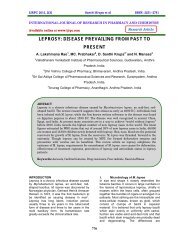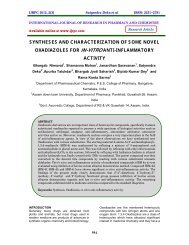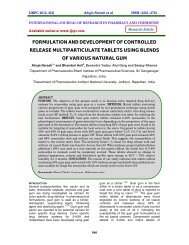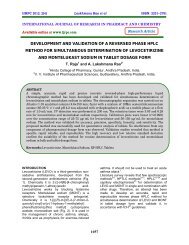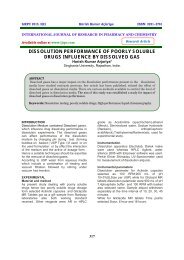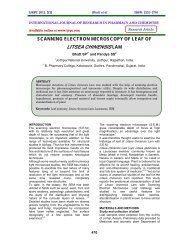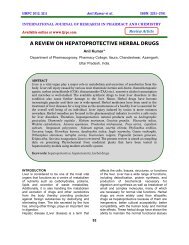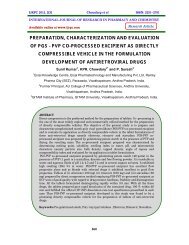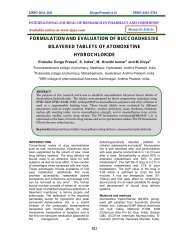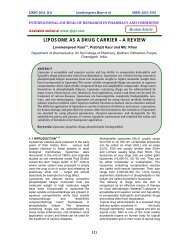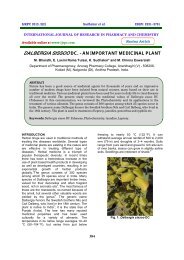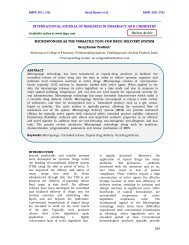prevalence of duchenne muscular dystrophy: a case report - ijrpc
prevalence of duchenne muscular dystrophy: a case report - ijrpc
prevalence of duchenne muscular dystrophy: a case report - ijrpc
Create successful ePaper yourself
Turn your PDF publications into a flip-book with our unique Google optimized e-Paper software.
IJRPC 2012, 2(1) Tamilanban et al. ISSN: 22312781<br />
INTERNATIONAL JOURNAL OF RESEARCH IN PHARMACY AND CHEMISTRY<br />
Available online at www.<strong>ijrpc</strong>.com<br />
Research Article<br />
PREVALENCE OF DUCHENNE MUSCULAR DYSTROPHY:<br />
A CASE REPORT<br />
T. Manasa, T. Tamilanban*, L. Nandhakumar and G. Dharmamoorthy<br />
Department <strong>of</strong> Pharmacology, Bharat Institutions, Ibrahimpattnam, Hyderabad,<br />
Andhra Pradesh, India.<br />
ABSTRACT<br />
Muscular <strong>dystrophy</strong> MD comprises a group <strong>of</strong> diseases characterized by progressive muscle<br />
weakness that induces functional deterioration. It is caused by mutation in dystrophin gene<br />
located on x chromosomes. This study aimed to investigate that certain people are affected by<br />
<strong>muscular</strong> <strong>dystrophy</strong> in Tirupati [A.P] particularly patients affected by DMD and BMD and to<br />
figure out the patients affected by different types <strong>of</strong> MD. The characteristics <strong>of</strong> different types<br />
<strong>of</strong> MD are discussed .The patients diagnosed with DMD [classified severe progressive MD]<br />
BMD (classified slow progressive MD) Around 43 <strong>case</strong>s have been <strong>report</strong>ed in the study area<br />
and 12 <strong>case</strong> were been <strong>report</strong>ed and projected in <strong>case</strong> study. The result revealing depicts that<br />
12 out <strong>of</strong> 7 are affected by DMD and 2 <strong>case</strong>s are affected by BMD remaining 3 refused muscle<br />
biopsy but having the symptoms <strong>of</strong> MD. Since most centers in developing countries have<br />
limited facilities for investigation <strong>of</strong> patients with MD and similar disorders. Laboratory<br />
techniques performed like ECG, EMG, 2DECHO, Serum creatine kinase and Muscle biopsy by<br />
using western blot method was performed. The main cause <strong>of</strong> concern is the ignorance and<br />
poverty line and below poverty line are the primary reasons. More over Muscular Dystrophy is<br />
prevailing in some part <strong>of</strong> socio economic zones as well. By giving proper hospitalization,<br />
awareness we can improve the life span <strong>of</strong> MD patients.<br />
Keywords: Muscular <strong>dystrophy</strong>, Duchenne <strong>muscular</strong> <strong>dystrophy</strong>, Becker Muscular <strong>dystrophy</strong>,<br />
clinical findings.<br />
.<br />
INTRODUCTION<br />
The <strong>muscular</strong> dystrophies are a group <strong>of</strong><br />
common and distressing neurological<br />
conditions with scarcely any effective<br />
treatment options available to date, despite the<br />
rapid strides in developing molecular diagnosis<br />
and the possibility <strong>of</strong> both pharmacological<br />
and genetic therapeutic strategies. The term<br />
‘<strong>muscular</strong> <strong>dystrophy</strong>’ traditionally refers to a<br />
group <strong>of</strong> genetically determined, progressive,<br />
degenerative disorders <strong>of</strong> muscle. Many<br />
patients can be diagnosed clinically as<br />
<strong>muscular</strong> <strong>dystrophy</strong>. The usual investigations<br />
carried out for such patients are estimation <strong>of</strong><br />
serum creatine kinase (CK),<br />
electrophysiological evaluation and<br />
histopathological examination. Diagnosis <strong>of</strong><br />
109<br />
<strong>muscular</strong> dystrophies and their classification<br />
for the purpose <strong>of</strong> prognostication requires<br />
evaluation with special immunohistochemical<br />
staining <strong>of</strong> histopathology specimens, which<br />
are available only at selected centers in<br />
developing countries like India. In developing<br />
countries, most centers have limited facilities<br />
for the investigation <strong>of</strong> such patients. As a<br />
result, investigations for patients with<br />
suspected <strong>muscular</strong> dystrophies are carried<br />
out according to the availability <strong>of</strong> investigative<br />
facilities, with no specific guidelines for their<br />
use. There are a number <strong>of</strong> myopathic<br />
disorders and some neurogenic disorders like<br />
congenital myopathies, mitochondrial<br />
disorders and spinal <strong>muscular</strong> atrophies,<br />
which may clinically mimic <strong>muscular</strong><br />
dystrophies and may be difficult to differentiate
IJRPC 2012, 2(1) Tamilanban et al. ISSN: 22312781<br />
from the latter, unless sophisticated<br />
investigations like immunohisto chemical<br />
staining <strong>of</strong> muscle biopsy specimens or<br />
genetic analyses are carried out. 1-4<br />
MATERIALS AND METHODS<br />
Detailed phenotype was noted in all the<br />
patients.Laboratory evaluation included<br />
complete heamogram,urinenalysis,serum<br />
biochemical analysis including muscle<br />
enzymes,ECG,2D ECHO, chest X-ray, nerve<br />
conduction(NC) and electromyography(EMG)<br />
and Muscular Biopsy western blot studies<br />
were performed. Some patients underwent a<br />
quadriceps muscle biopsy; serial sections<br />
were stained for light microscopy.<br />
CASE REPORT<br />
In Tirupati, 43 patients with <strong>muscular</strong><br />
<strong>dystrophy</strong> were observed. In our study, we<br />
have collected <strong>case</strong> <strong>report</strong> <strong>of</strong> 12 patients<br />
suffering with different types <strong>of</strong> MD since three<br />
years. The information was collected from<br />
Department <strong>of</strong> Neurology in various hospitals<br />
<strong>of</strong> Tirupati (AndhraPradesh, INDIA).<br />
Duchenne <strong>muscular</strong> <strong>dystrophy</strong> (DMD)<br />
Out <strong>of</strong> 12,7 <strong>case</strong>s <strong>of</strong> DMD-one was female<br />
and remaining 6 patients were male.5 patients<br />
started walking normally, but had the onset <strong>of</strong><br />
the disease before 5years <strong>of</strong> age.2 had onset<br />
<strong>of</strong> disease between 5 and 8 years. The mean<br />
age <strong>of</strong> onset was seen to be 6 years. The<br />
onset <strong>of</strong> disease was found in pelvic girdle<br />
musculature in 5 patients and with calfs<br />
hypertrophy.2 <strong>case</strong>s manifested onset with<br />
crural muscle weakness. The distribution <strong>of</strong><br />
muscle weakness is central to this disorder. In<br />
4 patients, weakness was global. These were<br />
advanced <strong>case</strong>s. Remaining 3 patients had<br />
pelvic girdle weakness, shoulder girdle<br />
weakness, distal muscle weakness, leg<br />
weakness and fore arm weakness. Facial<br />
weakness was seen in 2patients, hypertrophy<br />
was seen in the calves in 6 <strong>of</strong> the patients.2<br />
patients had gluteal, 3 patients each had<br />
deltoid and triceps and 2 patients had<br />
quadriceps hypertrophy. Mental backwardness<br />
was psychometrically confirmed in 2 patients,<br />
serum total creatine phosphokinase was found<br />
elevated (1675IU) , electromyogram was<br />
myopathic in 6 patients and ECG,persistent<br />
tachycardia commonly noted.atrial and<br />
ventricular beats and more complex or<br />
sustained ventricular ectopy which increase<br />
with age and ventricular dysfunction.Chronic<br />
respiratory insufficiency was <strong>report</strong>ed in all<br />
patients. Obstructive sleep apnea is<br />
110<br />
predominant in 4 patients. Intellectual disability<br />
is seen in 1 patient. Orthopedic complications<br />
like scoliosis develops in almost all patients,<br />
osteoporosis and loss <strong>of</strong> bone mineral density<br />
were observed.<br />
Becker <strong>muscular</strong> <strong>dystrophy</strong> (BMD)<br />
Out <strong>of</strong> 12 patients, 2 patients were affected by<br />
this type. Both were male. They had born <strong>of</strong><br />
consanguineous parentage. They had onset <strong>of</strong><br />
symptoms in the hip girdle, calf hypertrophy<br />
and with toe walking at onset. They were not<br />
mentally backward.Face, hip muscles,<br />
shoulder girdle was affected.Mean serum CK<br />
was elevated (4000IU), EMG was myogenic;<br />
muscle biopsy was diagnostic <strong>of</strong> <strong>dystrophy</strong> in<br />
both the patients.<br />
The remaining patient investigations revealed<br />
elevated serum CK values,EMG was<br />
myogenic in all patients,they were not mentally<br />
backward.Face,hip muscles,shoulder girdle<br />
was affected.In muscle biopsy,there was no<br />
<strong>dystrophy</strong> abnormalities.So,we can assume<br />
that they were autosomal recessive <strong>muscular</strong><br />
<strong>dystrophy</strong> or limb girdle <strong>muscular</strong><br />
<strong>dystrophy</strong>.But,due to lack <strong>of</strong> diagnostic<br />
specificity like dystrophin immuno staining and<br />
polymerase chain reaction(PCR) based<br />
dystrophin gene analysis for various muscle<br />
proteins and there is no detailed family history,<br />
we cannot asses the particular type <strong>of</strong> MD <strong>of</strong><br />
which these patients were affected.<br />
RESULTS AND DISCUSSION<br />
Out <strong>of</strong> the 12 patients studied with laboratory<br />
evaluation, serum biochemical analysis<br />
including muscle enzymes, ECG, EMG, 2D<br />
Echo, Chest X-ray, studies were performed.<br />
The mean CK value was 1675 IU for DMD<br />
boys. Muscle biopsies <strong>of</strong> boys with DMD can<br />
be demonstrated by western blot method<br />
analysis using antibodies directed against<br />
different epitopes <strong>of</strong> <strong>dystrophy</strong>. The amount <strong>of</strong><br />
dystrophin protein as well as size <strong>of</strong> the<br />
protein in DMD boys has less than 4% <strong>of</strong> the<br />
normal quantity <strong>of</strong> dystrophin is present when<br />
carboxyl terminal antibodies are used. Family<br />
history was positive in 2 patients and four<br />
patients were born <strong>of</strong> consanguineous<br />
marriage and one <strong>of</strong> the patients was born on<br />
non- consanguineous marriage. The mean<br />
age at presentation was 14-21 years. Two<br />
patients were affected by Becker <strong>muscular</strong><br />
<strong>dystrophy</strong> born <strong>of</strong> consanguineous marriage.<br />
Mean CK value was 4000IU. They underwent<br />
muscle biopsy by western blot method. The<br />
Immunoreactivity to carboxyl terminal<br />
antibodies is absent in DMD and is therefore<br />
useful in differentiating DMD from BMD. Due
IJRPC 2012, 2(1) Tamilanban et al. ISSN: 22312781<br />
to non-availability <strong>of</strong> gel-electrophoresis to<br />
study the deletion patterns <strong>of</strong> BMD has not<br />
performed. Remaining patients refused biopsy<br />
but they are having symptoms <strong>of</strong> <strong>muscular</strong><br />
<strong>dystrophy</strong> like progressive <strong>muscular</strong> wasting,<br />
poor balance respiratory difficulty was noted.<br />
Those patients mean age was 20-40 years<br />
affecting by different types <strong>of</strong> MD. An ECG<br />
performed on 12 patients by no abnormality <strong>of</strong><br />
rhythm was detected in any patient, 2D-Echo<br />
cardiograph was performed in12 patients and<br />
was abnormal in 9 patients those who are<br />
affecting by DMD and BMD <strong>muscular</strong><br />
diseases, suggesting reduced contractility <strong>of</strong><br />
the myocardium and segmental wall motion<br />
abnormality.<br />
Table 1: Summary <strong>of</strong> 2 Patients with Becker Muscular Dystrophy<br />
FEATURES Patient – 1 Patient – 2<br />
Gender Male Male<br />
Age at Presentation (Years) 14 15<br />
Age at onset (years) 13 14<br />
First symptom Hip girdle Calf hypertrophy<br />
Family History And Inheritance AD Nill<br />
Contracture Neck extensors Elbow flexors<br />
Weakness Proximal UL Proximal UL/PL<br />
Wasting Biceps, Triceps Arm, Anterior tibial<br />
Muscular stretch reflex Diminished Diminished(UL)<br />
Cardiac involvement Myogenic Myogenic<br />
Micellaneous Nill Hyptonia<br />
CK Elevated (7 times) Elevated<br />
NC Study Normal Normal<br />
EMG Myogenic Myogenic<br />
Table 2: Summary <strong>of</strong> 7 Patients with Duchenne Muscular Dystrophy<br />
Patient 1 2 3 4 5 6 7<br />
Gender(Female-F, Male-<br />
M)<br />
M M M M M M M<br />
Age at presentation<br />
(Years)<br />
2 7 18 17 18 6 5<br />
Age at onset (years) 1 3 1 4 6 3 1<br />
First Symptom DMF MB DMF DMF DMF DMF DMF<br />
Family history and<br />
inheritance<br />
AD AD AD AD AD AD AD<br />
Contracture<br />
Ankles<br />
Biceps<br />
Biceps<br />
Lliopsoas<br />
Biceps<br />
Ankles<br />
Biceps<br />
Ankles<br />
Biceps<br />
Ankles<br />
Biceps<br />
Ankles<br />
Biceps<br />
Lliopsoas<br />
Weakness P L\L P U\L muscle P U\L P U\L P L\L P L\L<br />
Wasting Neck extensors flexors Neck extensors Neck flexors<br />
Muscular stretch reflex D D D D D D D<br />
Micellaneous Hyptonia Hyptonia NIl NIl NIl NIl NIl<br />
CK level (1U/L E E E E E E E<br />
NC study N N N N N N N<br />
EMG M M M M M M M<br />
NOTE:-<br />
DMF - DELAYED MOTOR FUNCTION, D - DIMINISHED, E - ELIVATED, N - NORMAL, M - MYOGENIC.<br />
CONCLUSION<br />
Duchenne and Becker <strong>muscular</strong> <strong>dystrophy</strong> is a<br />
condition affect many boys and families<br />
remaining <strong>dystrophy</strong> like limb girdle,<br />
congenital, myotonic diseases not able to<br />
diagnose due to lack <strong>of</strong> hospitals and<br />
diagnostic facilities. Recent advance in<br />
symptomatic management, with the careful<br />
use <strong>of</strong> corticosteroids and respiratory support<br />
increase, physiotherapy improve muscle<br />
111<br />
strength, stem cell therapy, remaining search<br />
for a cure remains elusive, although may<br />
promising and novel therapies are in progress,<br />
some <strong>of</strong> which have entered the stage <strong>of</strong><br />
human trials. The main cause <strong>of</strong> concern is the<br />
Malnutrition, Environmental pollution, Gene<br />
Mutation, ignorance and the poverty linear<br />
below poverty line is the primary reasons for<br />
MD prevailing in some part social economic<br />
zone. The government has to curb the
IJRPC 2012, 2(1) Tamilanban et al. ISSN: 22312781<br />
situations or circumstances <strong>of</strong> these ailments<br />
which is quite imperative.<br />
REFERENCES<br />
1. Garima Shukla DM, Manvir Bhatia<br />
DM, Chitra Sarkar MD, Padma DM,<br />
Manjari Tirupati DM and Sathish Jain DM.<br />
Muscular dystrophies and related skeletal<br />
muscle disorders in an Indian population.<br />
Journal <strong>of</strong> clinical Neuroscience.<br />
2004;11(7):723-727.<br />
2. Wijmenga C, Frants RR and Hewwitt<br />
JE. Molecular genetics <strong>of</strong><br />
fasioscapulohumeral <strong>muscular</strong> <strong>dystrophy</strong>.<br />
Journal <strong>of</strong> neuro<strong>muscular</strong> disorder.<br />
1993;7(2):455-7.<br />
3. Kissel JT, Mendel JR. Muscular<br />
<strong>dystrophy</strong> historical review and<br />
classification in the genetic era. Semin<br />
Nevrol. 1999;238:347-50.<br />
4. Ye-jing Lue, Pong-Fong, Shun-Sheng<br />
Chen and Yen-mon lu. Measurement <strong>of</strong><br />
the functional status <strong>of</strong> patients with<br />
different types <strong>of</strong> <strong>muscular</strong> <strong>dystrophy</strong>.<br />
Kaohsiung journal <strong>of</strong> medical science.<br />
2009;25(6):200-209.<br />
112



